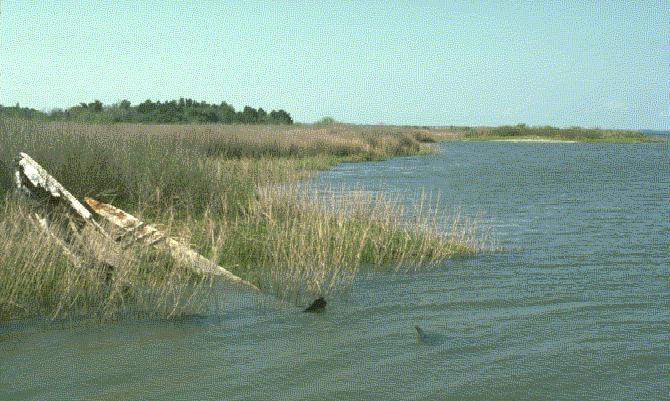| Home | main | Quiz1 | SAV | Nutrient pollution | Quiz2 |
 |
Welcome again--
So you are curious about these baygrasses,and want to know something about them huh. You came to the right place. |
Table of contents: |
|
| Introduction Species of SAV Causes for decline |
Importance Facts about SAV What's being done |
| How can you help? |
What is SAV? How is it important to bay's health?what do you need to know about it? |
Do you know you too can help restore the bay grasses? | |
Brief Introduction: |
||
| Beneath
the waters of the chesapeake bay, long streaming grasses sway with currents.Minnows and
juvenile crabs peep from behind the flowing fronds, hiding from larger fish that are
hunting for a midday snack. Occasionally, ducks poke their heads through the water’s
surface to nibble at the grasses’ tender tips. These Underwater grasses also called SAV -Submerged Aquatic vegetation is a diverse
assembly of rooted macrophytes found in shoal areas of Chesapeake bay, from its mouth to
the headwaters of its tributaries. SAV produces oxygen by photosynthesis, provides shelter for many fish and shellfish species.The main requirement for their survival is the quality of water in which they live. |
||
SAV species: |
||
| There are approximately about ten species of submerged aquatic vegetation found in Chespeake bay and its tributaries. They can be divided into three categories depending on the salinity tolerance: | ||
 |
|
|
Decline in SAV: |
||
| One of the major threats
to the bay ecosystem is the drastic reduction in the SAV beds. So, what are the factors influencing SAV reduction.The primary reason is---- We! meaning the people. Hard to believe huh!. So anyway what's really happening ? As we have learned earlier water quality is very important for the growth of bay grasses.Primarily the decline in SAV population is linked to excessive nutrients like nitrogen and phosphorus. Excessive amounts of nutrients are being released into the bay from sewage treatment plants,fertilizers used in the agricultural fields etc.These excessive nutrients trigger algal blooms (meaning rapid growth of algae).These algae clouds the water and reduces the amount of light reaching the SAV. When these algae die, their decomposition by bacteria uses lots of oxygen.
|
||
Importance of SAV: |
||
| The main importance of
SAV lies in it's being one of the primary indicators of bay's health. SAV beds are primary nursing grounds for crabs and many species of fish.Provides food and shelter for waterfowl, fish and shellfish.Also SAV beds provides habitat to many aquatic mammals. SAV produces oxygen which is very important for the growth of all living organisms. SAV acts as filter,traps the sediments.They reduces the wave energy and inturn reduces erosion. Decaying SAV proivides food to the microscopic zooplankton, provides shelter to the shedding bluecrabs until their shells has hardened.Along with the crabs, many fishes like sharks, rays, sea horses, herring and shad etc seek shelter in the sav beds. Not only the fishes and shellfish, many invertebrates are dependant on the sav beds in one way or another.For example sponges and sea squirts grow on the grasses, snails and many worms graze over the plants. Last but not least, SAV retains nitrogen and phosphorus and helps in removing excess nutrients. |
||
Facts about SAV: |
||
More than 200,000 acres
of bay grasses grew along the shoreline of the bay historically. But since 1960's over
half of the sav has disppeared from the bay.In 1984 only 38,000 acres of SAV were
reported. Current surveys find approximately 60,000 acres of under water grasses in the
Bay. This acreage represents a 66% increase over the 1983 low of 38,000 acres. However,
this is a mere 10% of the historic potential of 600,000 acres of underwater grasses. Now
our goal is that underwater grasses (submerged aquatic vegetation or SAV) should
cover 225,000 acres in the Bay and the tidal portions of its tributaries.
What is that we can do in improving SAVReduce the amount of fertilizers applied to
yards. Plant vegetation suited to your soil, moisture and climate conditions. What was being done for SAV protection:The U.S. Fish and Wildlife Service, other federal
and state agencies, and the Virginia Institute of Marine Science monitor SAV distribution
each year. By examining aerial photographs, locations of SAV are mapped for the entire
Chesapeake Bay and its tidal tributaries. By monitoring SAV in Chesapeake Bay, biologists
can determine which areas need to be protected. By examining historical distribution,
areas where SAV once flourished are targeted for restoration. Water quality is the key to restoring
grasses to the bay. Scientists have identified the water quality conditions and
requirements necessary for the survival of different SAV species. Managers are using these
requirements as the basis of recovery plans for various sections of the bay and its rivers
and creeks.The presence or absence of SAV reflects the general water quality of an
area.SAV can be used as a barometer to gauge the health of the bay and its tributaries. |
||
| Go to the Top | ||